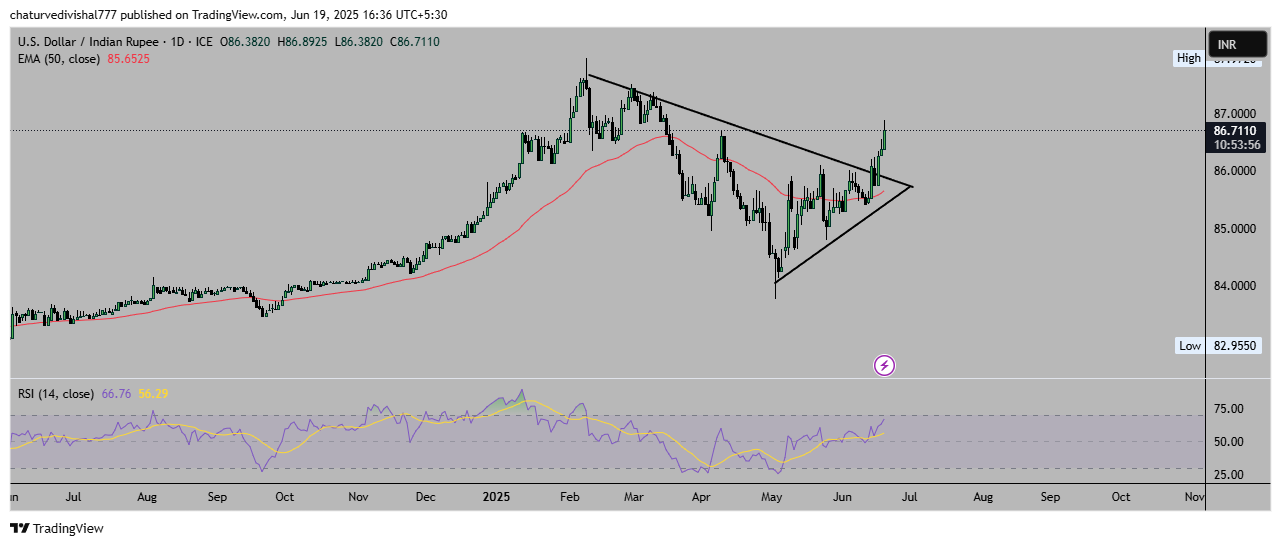Indian Rupee weakens to three-month low, oil rally persists amid Iran–Israel conflict
- Indian Rupee extends losing streak for the third consecutive day, hits weakest level since mid-March against the US Dollar.
- Israel–Iran conflict enters seventh day, US reportedly prepared for possible military strike.
- Brent and WTI crude are up over 20% this month, supply fears keep prices elevated.
The Indian Rupee (INR) extends its losing streak for a third consecutive day against the US Dollar (USD) on Wednesday, sliding to a three-month low as the escalating Middle East conflict fuels fresh supply worries and keeps Crude Oil prices elevated. Higher Oil costs continue to strain India’s import bill, adding persistent pressure on the Rupee.
The USD/INR pair is trading higher near ₹86.79 during the American trading hours, as holiday-thinned liquidity keeps price action subdued. The pair remains slightly below its intraday peak of ₹86.89 touched earlier in the European session. Meanwhile, the US Dollar Index (DXY), which measures the Greenback’s strength against a basket of six major currencies, holds steady around 99.00 after the Federal Reserve (Fed) left interest rates unchanged on Wednesday, reinforcing broad Dollar resilience amid an already uncertain global outlook. With US financial markets closed on Thursday for the Juneteenth holiday, trading volumes are light and fresh momentum is likely to return once liquidity picks up on Friday.
As the Iran–Israel conflict enters its seventh day, both nations have continued heavy strikes — Israel targeting Iran’s nuclear and military installations, and Iran responding with waves of ballistic missiles and drones toward Israeli territory, including civilian hospitals. The US has reinforced its regional posture by deploying additional naval vessels and aircraft assets to serve as a deterrent amid rising tensions. US President Donald Trump has publicly backed Israel’s campaign, praising its strikes as “excellent” and warning Iran of “even more brutal” action if it fails to capitulate on its nuclear ambitions. Trump remains non-committal about direct US military involvement, saying, “I may do it. I may not do it. I mean, nobody knows what I'm going to do.”
Market Movers: INR at three-month low, Oil surges on supply fears, Fed holds rates
- The Indian Rupee falls to its lowest level since mid-March against the US Dollar on Thursday as heightened risk aversion gripped financial markets, with traders bracing for the possibility of direct US involvement in the Israel–Iran conflict.
- CRISIL reported that India’s headline retail inflation, measured by the Consumer Price Index (CPI), eased to 2.8% in May 2025, thanks largely to cooling food prices—a positive sign for the economy. However, the ratings agency flagged that core inflation, which strips out volatile food and fuel costs, is ticking higher. This uptick in core prices usually indicates firm domestic demand, but CRISIL noted that the latest rise is more a result of global economic turbulence than strong local consumption, hinting at fresh policy challenges ahead.
- In an exclusive interview with NDTV, India’s Petroleum and Natural Gas Minister Hardeep Singh Puri reassured markets that the country has enough oil reserves to manage any near-term disruptions stemming from the Iran–Israel conflict. “We are constantly monitoring the situation. No reason to worry about energy count. India has sufficient energy reserves to last for weeks,” Puri said, adding that authorities remain vigilant as crude prices surge on supply concerns.
- Speculation over a potential Iranian blockade of the strategic Strait of Hormuz has intensified after a former Iranian minister suggested oil and LNG shipments should pass only with Tehran’s approval. India’s Petroleum Minister Hardeep Singh Puri sought to allay concerns, stating that only a small share of India’s oil imports—about 1.2 million barrels per day—actually transit the Strait, while the bulk comes from Russia and other sources. Puri added that India has contingency plans to boost domestic production, curb exports if needed, and diversify purchases to manage any supply shock
- The Iran–Israel conflict has driven a sharp rally in Oil prices, with Brent crude futures last trading near $76.78 per barrel, marking a gain of over 20% so far this month. West Texas Intermediate (WTI) is holding around $75 at the time of writing, up roughly 22% month-to-date. Escalating hostilities and fears of potential US involvement have stoked fresh supply concerns, keeping both benchmarks well bid despite subdued holiday trading in the US.
- Oil makes up a significant portion of India’s total imports, and economists estimate that every $10 per barrel rise in crude prices can expand the country’s current account deficit by as much as 0.4% of GDP.
- The deepening Middle East conflict threatens key Indian trade corridors. Payments for basmati rice exports to Iran, worth more than ₹6,374 crore in FY25, are seeing delays of over 180 days. New security checks cloud India’s robust $10.1 billion trade with Israel. Meanwhile, India’s strategic bet on Iran’s Chabahar Port, with $85 million invested to tap Central Asian routes, hangs in the balance as the port’s security outlook turns fragile.
- Fresh reports intensified market jitters late Wednesday, with The Wall Street Journal revealing that US President Donald Trump had given private approval for potential military action against Iran but paused the final directive to gauge Tehran’s willingness to halt its nuclear efforts. In parallel, Bloomberg reported that US defense officials are actively preparing for a possible strike on Iranian targets in the near term. This rising threat of broader conflict has boosted Crude Oil prices.
- Israel continues to defend its ongoing military operations by claiming Iran is on the verge of acquiring nuclear weapons capabilities. While the International Atomic Energy Agency (IAEA) has confirmed there were “no radiological effects” from Israel’s recent strike on Iran’s Arak reactor, global concerns over Tehran’s nuclear ambitions remain a central factor fuelling the conflict.
- US President Donald Trump, whose administration revived the “maximum pressure” campaign to curb Iran’s nuclear pathways and regional influence, has now warned Tehran against retaliating by hitting American interests. He declared that any attack on the US would trigger a response with “the full strength and might of the U.S. Armed Forces” at levels “never seen before.”
- The Fed kept its benchmark interest rate unchanged at the 4.25%–4.50% range on Wednesday, sticking to a cautious approach as officials balance moderate economic growth with persistent inflation risks. Policymakers hinted at the possibility of two rate cuts before the end of the year but stressed that any adjustment would depend on how inflation and broader economic data evolve in the coming months.
- Fed Chair Jerome Powell emphasised caution on Wednesday, warning that the Fed’s economic projections are far from ironclad. Powell urged markets not to over-rely on the “dot-plot,” noting that all future rate decisions will remain data-dependent. He framed the messaging as “no one holds these rate paths with a great deal of conviction,” underlining the central bank’s adaptive stance.
USD/INR Technical Outlook: Strong triangle breakout fuels bullish momentum

The USD/INR pair has staged a strong breakout from a multi-month symmetrical triangle pattern on the daily chart, printing consecutive bullish candles that signal renewed upward momentum. Price action remains comfortably above the breakout zone, with the 50-day Exponential Moving Average (EMA) near 85.65 now acting as dynamic support if any profit-taking emerges.
The daily Relative Strength Index (RSI) is holding around 66, indicating healthy bullish momentum with room to test overbought levels before any pullback. If the pair maintains this bullish structure, a clear push above the 87.00 round number could pave the way toward the next resistance at 87.50–88.00. On the downside, dips back toward 86.00–86.20 may attract fresh buying interest, keeping the broader uptrend intact.
Indian Rupee FAQs
The Indian Rupee (INR) is one of the most sensitive currencies to external factors. The price of Crude Oil (the country is highly dependent on imported Oil), the value of the US Dollar – most trade is conducted in USD – and the level of foreign investment, are all influential. Direct intervention by the Reserve Bank of India (RBI) in FX markets to keep the exchange rate stable, as well as the level of interest rates set by the RBI, are further major influencing factors on the Rupee.
The Reserve Bank of India (RBI) actively intervenes in forex markets to maintain a stable exchange rate, to help facilitate trade. In addition, the RBI tries to maintain the inflation rate at its 4% target by adjusting interest rates. Higher interest rates usually strengthen the Rupee. This is due to the role of the ‘carry trade’ in which investors borrow in countries with lower interest rates so as to place their money in countries’ offering relatively higher interest rates and profit from the difference.
Macroeconomic factors that influence the value of the Rupee include inflation, interest rates, the economic growth rate (GDP), the balance of trade, and inflows from foreign investment. A higher growth rate can lead to more overseas investment, pushing up demand for the Rupee. A less negative balance of trade will eventually lead to a stronger Rupee. Higher interest rates, especially real rates (interest rates less inflation) are also positive for the Rupee. A risk-on environment can lead to greater inflows of Foreign Direct and Indirect Investment (FDI and FII), which also benefit the Rupee.
Higher inflation, particularly, if it is comparatively higher than India’s peers, is generally negative for the currency as it reflects devaluation through oversupply. Inflation also increases the cost of exports, leading to more Rupees being sold to purchase foreign imports, which is Rupee-negative. At the same time, higher inflation usually leads to the Reserve Bank of India (RBI) raising interest rates and this can be positive for the Rupee, due to increased demand from international investors. The opposite effect is true of lower inflation.



